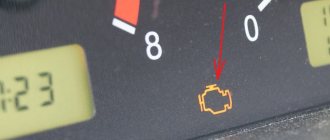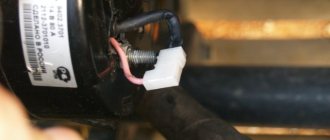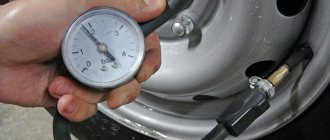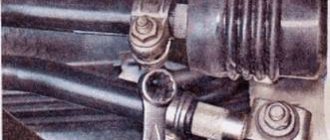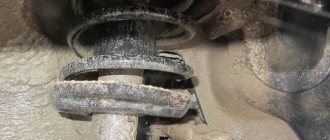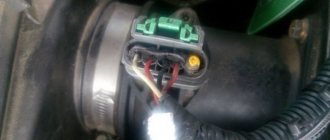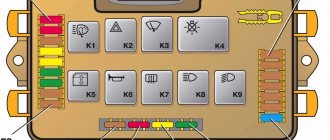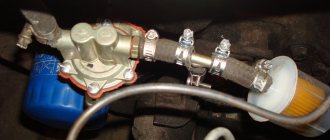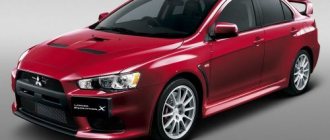Backlash is a term in mechanics that implies the presence of free movement in an element of a mechanical system. It represents a parameter by which one can judge the amount of movement of the node mentioned above to obtain a response from another - the controlled node.
In other words, the amount of backlash is characterized as the amount of rotation or displacement of the controlled element, which does not lead to any changes in the object.
In relation to a car and steering, the angle of rotation of the steering wheel at which the car continues to move in the same direction.
What is meant by total steering wheel play?
Another term that requires consideration is “total backlash.” It refers to the total angle, which starts from the extreme position of the steering wheel on one side when turning begins, to the opposite position when the car starts moving in the other direction.
To understand the principles of operation of the total backlash, it is important to understand the design and operating features of the control system. Based on the technical component, the operating principle of the backlash is as follows.
There is a rod in the transmission of steering rods, which is fixed with a small gap of one or two millimeters.
This distance is necessary to protect the steering system linkages from wear due to excessive friction.
The presence of a gap is a technological solution that allows you to keep the hook in the required position and not touch the surface of the teeth.
For the driver, this parameter represents free movement of the steering wheel, which allows for more precise control of the car and to feel at what moment the direction of movement of the vehicle changes.
Essentially, this is the total distance the steering wheel travels before the car moves to the left or right.
Many people mistakenly consider this phenomenon negative and try to get rid of it. You shouldn’t do this, because play in the steering is the norm for every car. Another thing is that it must have a strictly defined value.
An interesting pattern can be traced here - the larger the car’s dimensions, the higher the backlash indicator.
In the process of measuring the total backlash, a number of conditions must be met:
- The front wheels are located in a neutral position and stand on a hard (asphalt or concrete) surface.
- The steering wheel tires are dry and clean.
- The car engine is started. This is relevant if the operation of the power steering is tested.
- The tension of the power steering pump drive belt, as well as the level of the working fluid, must meet the requirements approved by the manufacturer.
The total play is checked by measuring the angle of rotation of the control wheel between the fixed positions for changing movement to the left and right.
To obtain accurate parameters, measurements are made two or more times.
Steering design
The design of the steering system in modern cars is almost the same for most models produced; there are only minor differences.
- Steering wheel.
- Cardan-type intermediate joint.
- Steering gear.
- Left and right pulls.
- Internal and external tips.
- Adjustment rods.
Permissible backlash in cars
The traffic regulations stipulate normalized indicators of total play for various cars. In addition, this parameter should not exceed the figures specified in the documentation for the operation of the machine.
If there are no special recommendations in the manufacturer’s papers, the backlash should be as follows:
- For passenger cars, as well as bus and truck components made on their basis - 100;
- For buses - 200;
- For trucks - 250.
There are also separate recommendations for some models:
- For VAZ-2106, 2107, 2110, 21213 - 50;
- For Gazelle 3302 - 200 (passenger version) and 250 (truck).
What is steering play, its causes and elimination
- What is steering play, its causes and elimination
- What is steering play
- Permissible steering wheel play
- What tool is used to check
- How to check
- Possible causes of play and their diagnosis
- Engine off
- When driving
- When braking
- How to eliminate backlash
- In the steering column
- Video: Eliminating steering play
- Steering wheel
A car is not only a means of transportation, but also a mechanism that can endanger human life. Frequent use wears out car parts and causes them to malfunction. From this article you will learn about steering play and how to remove it, the causes of it and how to measure it. It will also become clear what value of play can be allowed.
- What is steering play
- Permissible steering wheel play
- What tool is used to check How to check
- Engine off
- In the steering column Video: Eliminating play in the steering wheel
Reasons for large backlash
The increase in play can be explained by changes in the design features of the steering, as well as the destruction of their elements.
The main reasons include:
- Worn gear bar and steering rack gear teeth.
- Damage or deformation of the wheel bearing. There are cases when it falls apart during operation, which leads to an increase in backlash (but there will be no time for backlash).
- Malfunction of tips and tie rods, which often break if operating requirements are not followed. The result is the same as in the previous case - “looseness” of the steering wheel.
- Poor quality repair of the vehicle chassis. There are situations when steering play manifests itself after visiting a service station. This is possible when service technicians do not tighten the wheel bearing nut sufficiently. As a result, the car's steering system suffers.
- Breakage of the ball joint (lower or upper), as well as pulling the steering rack with excessive force.
- Outdated hydraulic oil that requires replacement. Often play in the steering is eliminated after filling with new working fluid.
Generally speaking, play occurs when there is a fault in the chain between the steering wheel and the wheels.
To find out the reason, you need to go through the entire chain and identify the “weak” points. The main thing is to make sure that we are talking about increased free play, and not about other problems.
Other causes of play in the steering include:
- Wear or incorrect adjustment of the engagement of the “worm” and the roller mechanism.
- Worn swing arm axle or bushings.
- Loose crankcase fasteners.
Adjusting the steering wheel play: how to reduce the free play of the gearbox, tighten the steering column
The steering wheel control mechanism undergoes considerable load during constant driving. It turns out that most of its component systems operate in extreme mode, which, in turn, leads to rapid wear. One of the common malfunctions that drivers have to deal with is an increase in play in the steering wheel, when the car responds with a delay to commands given to it. To fix the problem, you don’t have to go to a service station; you can carry out the repair yourself if you know how to do it correctly.
Reasons for the increase
The reason for the increase in play may be a malfunction of one of the links in a whole chain of parts, from the steering wheel to the wheels, including the rack and rods. To avoid missing anything, a step-by-step inspection should be carried out. There are cases when a driver discovers the appearance of play after picking up the car from a service station where the chassis was repaired. This sometimes happens if, during the repair process, the mechanic simply forgets to tighten the wheel bearing nut, and this seemingly minor oversight will lead to serious consequences.
If this situation does not apply to you, start by checking the reliability of the steering wheel. It happens that even a slightly loosened fastening nut can cause the amount of play to be overestimated. If everything is in order with this, start identifying the cause by diagnosing the steering rods, carefully examine the tips - these parts often fail, which may well lead to an increase in play. If there are no problems with the rods and tips, pay attention to the wheel bearing - its half-collapsed and, moreover, completely collapsed state can also cause the steering wheel to move freely.
An important link in converting steering wheel movement into tire rotation is the steering rack. This is a central control unit, the error of which immediately makes itself felt by knocks heard in the area of the front axle, especially when moving on a bumpy road. The reason for the increase in steering play may lie in incorrect adjustment of the rack, or rather, in its tightening.
Something else worth paying attention to is the condition of the front suspension ball joints. These parts allow the front wheels to move forward and backward freely and make turning maneuvers. If one of them, upper or lower, fails, this will cause the steering to malfunction. Malfunctions are often accompanied by a clanging sound from the front of the car. Finally, one of the most common reasons for the appearance of free play in the steering may lie in the fact that the hydraulic oil has expired and needs to be replaced.
Important! Hydraulic oil should be changed at least once a year for low-intensity use or once every 8 months for constant use.
Signs of breakdown
As noted above, in order to effectively eliminate a malfunction, it must be diagnosed in a timely manner. To do this, it is enough to know the signs of play in the steering.
The main symptoms include:
- The appearance of a knock in the steering mechanism;
- Increased vibrations while driving;
- Creaking when turning wheels;
- Deviation from a given trajectory when the steering wheel is in a straight position.
When adjusting the steering play, you should take into account the manufacturer’s recommendations and traffic rules.
The configured parameter should not exceed the upper limit, but you should not underestimate the indicator either.
Too little steering wheel play can lead to additional discomfort and poor vehicle controllability.
At the same time, you should not ignore the appearance of a small backlash, because over time this parameter may increase, and then it will be more difficult to deal with the problem.
And it’s inconvenient to drive a car when you constantly have to “catch the road” and turn the steering wheel in one direction or the other.
Also read about the causes of knocking when turning the steering wheel.
The concept of play in the steering mechanism
In relation to the steering of a car, play is the amplitude of rotation of the steering wheel at which the car continues to move in the same direction.
A special rod, one of the steering elements, does not fit tightly to other parts, forming a gap. Due to this, the elements of the mechanism do not wear out during friction. The traffic rules set the maximum gap to no more than 10 degrees. Exceeding this value makes the car impossible to operate and requires immediate elimination.
Diagnosis of the problem and instruments used
To determine whether the parameter corresponds to the norm, you need to do a small check.
To make sure there is a problem, you can use a special device - a backlash meter.
With its help you can check the total (total) play in the system.
One of the device options is K 524 M or ISL-M, which can be used by ordinary car owners and professionals at service stations.
Using a backlash meter, it is possible to determine the amount of free play in just three minutes, including taking into account installation and removal of the device.
The algorithm for diagnosing steering play is as follows:
- Start the engine (it should be idling);
- Place the front wheels parallel to the longitudinal axis of the machine. At the same time, make sure that the hydraulic booster is working;
- Turn the steering wheel one way and then the other. At this moment, record the moments when the front wheels begin to scroll in the required direction. The distance that the steering wheel travels between these intervals is called play (free play).
This check is considered an excellent option for drivers who need accurate and quick information.
It does not matter how the problem was diagnosed. If the steering play exceeds the norm, it must be eliminated.
Eliminating play in the steering
To adjust the steering, you will need the usual set of simple tools to adjust the mounts. All troubleshooting work is carried out in a garage with an inspection pit, overpass, or with a lift.
If the playmeter or manual diagnostics show unsatisfactory results, proceed to the following actions (the help of a partner will be required):
- Determine the source of the knock and check the operation of the suspensions.
- Try to tighten the steering bar.
- Holding the steering wheel, turn it from side to side within the limits of free play, while simultaneously observing the operation of the driveshaft near the rack and ball joints. And also monitor the tightness of the mating rods, which must fit exactly into one another.
- If the steering rack is not damaged, turn the adjusting screw to eliminate the play in the rack.
- Free play in the cardan shaft most often occurs due to lack of lubrication. It can be eliminated only by replacing the part.
- Backlash at the junction of the rods is eliminated by spot welding, which holds the parts together during operation.
- Repair or replace ball ends if necessary.
- Pay special attention to the serviceability of the tips and the integrity of the rubber boots.
- Check whether the steering wheel play has been eliminated.
If all actions do not lead to the desired result, all that remains is to completely disassemble the steering mechanism to determine which parts are faulty and replace them.
The safety of the driver and passengers directly depends on the proper operation of the steering mechanism. Correcting breakdowns and adjusting mechanisms is best left to professionals.
How to adjust steering play
And finally, another reason for play in the steering is loosening of the adjusting rods, which are designed to adjust the toe-in of the car's wheels. This is a consequence of poor tightening of the bolts on these rods after adjusting the toe angle, and can lead to the adjusting rod popping out of the tip.
On some modern car models, the swing arms are not welded to the suspension struts, but are bolted together. The weakening of these connections also leads to the appearance of the described trouble. To exclude this option when determining the cause that led to it, you need to lift the front of the car and remove the wheels and check the tightness of the above connections, thereby adjusting the steering.
What is backlash
The total steering play of any car, including a bus, is the angle by which the steering wheel deviates when turning it left and right, to the point where the bus wheels begin to turn.
Each bus manufacturer indicates the deviation in its documentation for the bus, and the angle obtained as a result of field tests should not be greater than specified.
If the value is not indicated in the documentation, then in fact it should not be greater than the value established in state regulations.
The backlash value is set for each type of vehicle, including buses, and it should be:
- passenger vehicles – 10 degrees;
- buses - 20 degrees;
- trucks – 25 degrees.
Principle of operation
To understand what steering play is, consider the principle of operation of steering systems in a modern car. The steering wheel is connected through a cardan joint to a mechanism that is a hollow (usually duralumin) tube, inside of which there is a gear rack moved by a gear connected to the cardan joint. The rack is connected through internal tips to rods, which are connected through external hinges to the steering arms on the front suspension struts. Thus, any movement of the rack leads to the rotation of the wheels and any play in the steering can lead to serious consequences from a delayed reaction to movement to a complete loss of control of the car.
We recommend: Pneumatic braking system for tractors and trailers. Design
Reasons for play in the steering:
- poor tightening of the steering wheel nut;
- wear of spline joints;
- wear of the cardan joints of the intermediate shaft;
- loosening of the steering mechanism to the body;
- increased gap between the rack and gear in the mechanism;
- tip wear;
- wear of the rubber-metal hinges securing the rods to the mechanism or weakening of their fastening bolts;
- loosening the adjusting rods.
The play may be accompanied by a knocking sound in the steering column, which may indicate wear of the parts.


